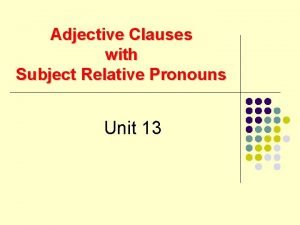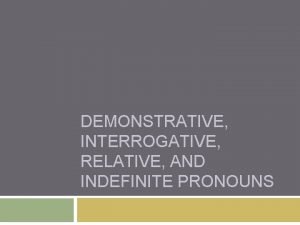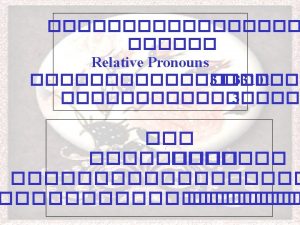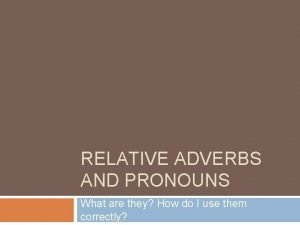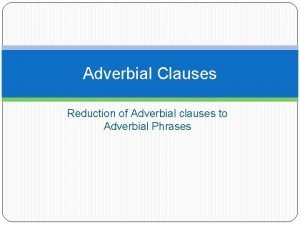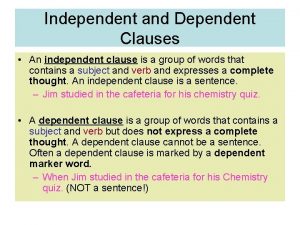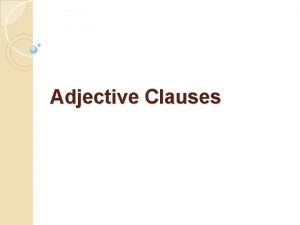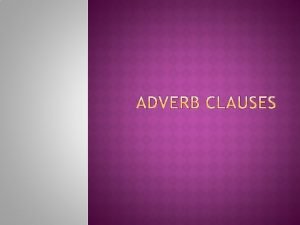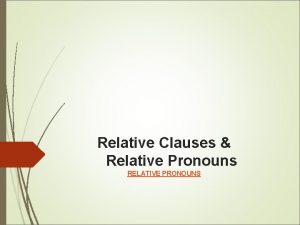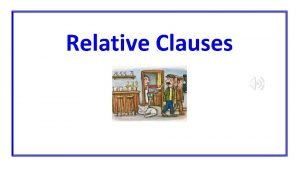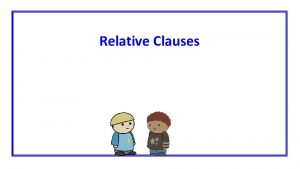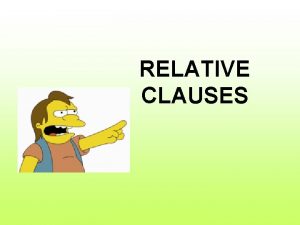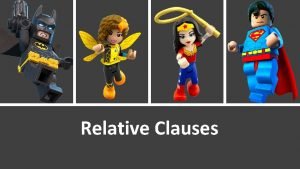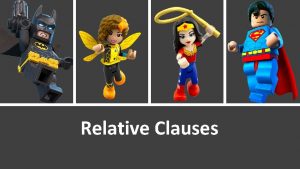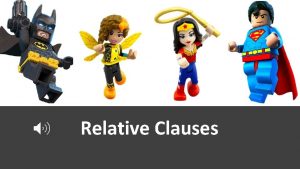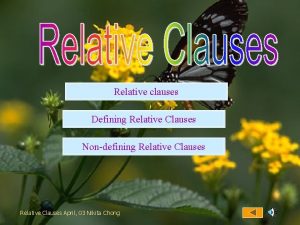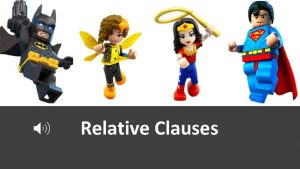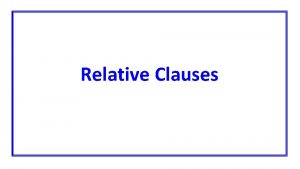Relative Clauses Relative Pronouns Relative pronouns are used














- Slides: 14

Relative Clauses

Relative Pronouns Relative pronouns are used differently to other pronouns. They introduce a relative clause. Relative Pronouns who, which, where, when, whose, that

Relative Pronouns They can relate the clause to a noun. Old Deuteronomy, who was sleepy, licked his tail. Old Deuteronomy licked his tail which he coiled towards him. Old Deuteronomy, whose tongue was very rough, licked his tail. Old Deuteronomy licked the bite that the mouse had given him. Relative Pronouns who, which, where, when, whose, that

Relative Clauses Relative clauses can also relate to a whole clause. The cat caught the canary, which annoyed its owner. This is a clause. It is not the cat which annoyed the owner. It is the catching of the canary. The relative clause relates to the whole clause.

Spotting Relative Clauses Relative clauses are a type of subordinate clause. main clause subordinate clause Gumbie slept on the bed which was a very comfortable one. The main clause is the main part of the sentence. It makes sense by itself. The subordinate clause adds meaning to the main clause; it has less weight. When the subordinate clause is a relative clause, it adds meaning to a noun in the main clause or to the whole main clause. Revision

Spotting Relative Clauses Old Deuteronomy stretched in the sunlight which was warm and comforting. Gumbie sat on the hat which she had found on the hall table. Identify the main clause and relative clause in each sentence. What noun is the relative clause relating to?

Answers main clause subordinate clause Old Deuteronomy stretched in the sunlight which was warm and comforting. main clause subordinate clause Gumbie sat on the hat which she had found on the hall table. Identify the main clause and relative clause in each sentence. Which noun is the relative clause relating to?

Punctuating Relative Clauses When the relative clause comes after the main clause, we do not usually separate the clauses with a comma. main clause subordinate clause Old Deuteronomy ignored the noise which was coming towards him. A comma would create an unnecessary break in the sentence.

Punctuating Embedded Relative Clauses Sometimes the relative clause is embedded in the main clause The mice ate the cheese. Tell me more about The mice. The relative clause needs to be next to the noun: the mice.

Punctuating Embedded Relative Clauses Sometimes the relative clause is embedded in the main clause The mice, who did not know about the joke, ate the cheese. Tell me more about the mice. The main clause splits to make space. . .

Punctuating Embedded Relative Clauses Sometimes the relative clause is embedded in the main clause subordinate clause main clause The mice, who were happy to have tasty food, ate the cheese. Commas separate the clauses because the relative clause breaks up the main clause. Tell me more about the mice. The main clause splits to make space. . . for the relative clause.

Embedding Relative Clauses main clause Gumbie slept on the papers. The dog skirted around Old Deuteronomy. The bed looked tempting to the cat. The mouse ate all the cheese and bacon. Read these main clauses. Embed a relative clause to say more about the noun. Remember to use commas.

What meaning did you add to the clauses? main clause , subordinate clause , main clause Gumbie, who was tired after a busy night, slept on the papers. The dog, who did not want to disturb his sleep, skirted around Old Deuteronomy. The bed, which had been made that very morning, looked tempting to the cat. The mouse, whose stomach had been rumbling, ate all the cheese and bacon. Check your punctuation.

Explore more Hamilton Trust Learning Materials at https: //wrht. org. uk/hamilton/.
 Insidan region jh
Insidan region jh Relative clauses and relative pronouns stage 15
Relative clauses and relative pronouns stage 15 The person who phoned me last night is my teacher.
The person who phoned me last night is my teacher. Non identifying adjective clauses examples
Non identifying adjective clauses examples Adjective clauses with object pronouns
Adjective clauses with object pronouns Relative pronoun as possessive
Relative pronoun as possessive Demonstrative and relative pronoun
Demonstrative and relative pronoun Decide whether the relative pronouns must be used or not
Decide whether the relative pronouns must be used or not Relative adverbs and pronouns
Relative adverbs and pronouns Restrictive clause
Restrictive clause Reducing adverb clauses to phrases
Reducing adverb clauses to phrases What does an independent clause contain
What does an independent clause contain Adjective clauses
Adjective clauses Using adverb clauses to show time relationships
Using adverb clauses to show time relationships Relative clauses extra information
Relative clauses extra information




